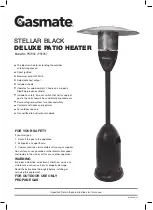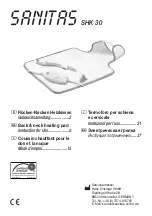
9/49
GAS REQUIREMENTS
•
Use only the type of gas and the type of cylinder specified by the manufacturer.
•
The appliance can be used with gas cylinders having a maximum capacity of 15 kg.
•
Replace the gas bottle in a well ventilated area, away from flames and heat sources (candles,
cigarettes, other flame appliances).
•
The pressure regulator and hose assembly to be used must conform to local standard code.
•
0,5 m flexible hose. We recommend frequency of checking the flexible hose (at least once per month
and each time the cylinder s changed). If it shows signs of cracking, splitting or other deteriorations it
shall be exchanged for new hose of the same length and of equivalent quality. The flexible hose
must be changed within the prescribed intervals.
•
Use only original spare part.
•
The installation must conform to local codes, or in absence of local codes, with the standard for the
storage and handling of liquid petroleum gases.
•
The gas cylinder must be stored in accordance with the regulations in force.
•
A dented, rusted or damaged propane tank may be hazardous and should be checked by your tank
supplier. Never use a propane tank with a damage valve connection.
•
The propane tank must be arranged to provide for vapour withdrawal from the operating cylinder.
•
Never connect an unregulated propane tank to the heater.
LEAKAGE TEST
Gas connections on the heater are leak tested at the factory prior the shipment. A complete gas
tightness check must be preformed at the installation site due to possible miss handling in shipment or
excessive pressure being applied to the heater.
Check the tightness of the connection
.
The whole gas system, hose regulator, pilot or burner should be
inspected for leaks or damage before use.
Do not use the heater until all connections have been leak tested. Turn off immediately the gas valve if
smell of gas is detected.
In event of gas leakage, the appliance shall not be used or if alight, the gas supply shall be shut off and
the appliance shall be investigated and rectified before it is used again.
All leak tests should be done with a soap solution. Never use an open flame to check for leaks.
•
Make a soap solution of one part liquid detergent and one part water. The soap solution can be
applied with a spray bottle, brush or rag. Soap bubbles will appear where a leak is present.
•
The heater must be checked with a full cylinder.
•
Make sure the safety control valve is in the OFF position.
•
Turn the gas supply ON.
•
If a leak is present, turn off the gas supply. Tighten any leaking fittings, then turn the gas supply on
and re-check. .
•
Never leak test while smoking.
Summary of Contents for 6541090
Page 37: ...37 49 ...
Page 38: ...38 49 ...
Page 39: ...39 49 ...
Page 40: ...40 49 ...
Page 41: ...41 49 ...
Page 42: ...42 49 ...
Page 43: ...43 49 ...
Page 48: ...48 49 FEILSØKING NO ...










































